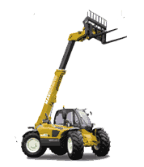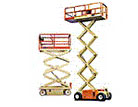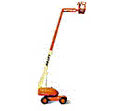News
Forklift won't start after swapping LP bottle?
By Dennis Firkins - February 13, 2020
Did you just change your LP tank after running out of fuel and the lift won’t restart?
Here are some things to check out before placing a call for service!
- Remove the LP connector from the full tank that was just installed. Look at the inside of the brass tank coupling. You should NOT see any O-Rings or Flat-Rings inside the brass coupling.
- The LP tank fitting (where the tank coupling screws on) DOES have a Flat-ring on the outside to keep dust out and an O-Ring back inside that seals against the shiny tip on the tank coupling.
- Occasionally, when you change out an LP tank, the Flat-Ring out of the old tank will pull off and stick inside the LP hose coupling, preventing the coupling from screwing on far enough to open the valve. The engine will not have fuel to start and it will not run.
- If the LP Tank Coupling is screwed onto the LP Tank Fitting properly, there will only be an 1/8†of gap between them. If you are not able to screw them together that close, check again for something in the Tank Coupling. There should not be any rubber Rings in the Tank Coupling.
- Sometimes, you will need to lubricate the shiny tip of the LP Tank Coupling to get it to slide past the O-Ring in the Tank Fitting. Chapstick works well for this.
- If all of this fails to get the forklift started, call us for a service call and we will dispatch one of our qualified technicians to get the lift going for you!
Thank you!
Â
Looking to upgrade your old/tired forklift?
By Western Material Handling Admin - January 6, 2020
(2) Awesome running 2014 Hyster S50FT, 5,000# Cushion tire forklift with the desirable 200†triple stage mast with side-shift carriage, 42†forks, Fingertip controls for hydraulics, comfortable full-suspension seat, foot heater, great smooth cushion tires, lever shift transmission, new paint job & new PM service! Â
Ready for work!
ELECTRIC SCISSOR LIFT TO MAKE LIFE EASIER!
By Western Material Handling Admin - December 2, 2019
700 lb. Capacity
32’ platform height and approx. 38’ working heightÂ
24volt battery system with built-in 110volt charger
Great treaded cushion tires
Recent repairs, and new PM service!
ONLY 200 HOURS!!
Ready for work!
TRAINING ON YOUR BATTERY
By Western Material Handling Admin - November 25, 2019
Proper Battery Care
CHARGING:
- Under normal circumstances, we recommend charging when a battery reaches 80% depth of discharge (near the “red zone†on most discharge meters or about 1.140-1.60 specific gravity), not before.
- Most new batteries are designed to provide 1,500 charge “cycles†or more. A normal cycle is 8-hours usage, 8-hours charging, and 8-hours cooling per a 24-hour period. If your application is light to medium duty, or sporadic, charge only when necessary rather than daily. It will spread the cycle life of the battery over a much longer period of time, and ensure you get the maximum number of productive years from your investment.
- Select “weekendâ€, “equalize†or “weekly†charge (depending on your brand of charger) approx. every 5 to 10 cycles to keep the battery performing at peak efficiency. Failure to do so or selecting this option too often will harm the battery and shorten its effective life.
- New batteries require water approx. every 10 charges for the first few years. Reconditioned batteries may require water every 5 charges.
- On both new and reconditioned batteries, we recommend you check 2 or 3 pilot cells every 5 charges to see that the water level is just above the red perforated plastic Element Protector after charge (color varies depending on brand).
- If low, add only enough water to cover the Element Protector by approx. ¼â€. The additional space is necessary for expansion while gassing at the end of charge.
CLEANING:
- If a battery ever overflows, take a few minutes to rinse it with water immediately afterwards (baking soda optional) to prevent corrosion on top of and beneath the battery. Use enough water to thoroughly dilute the spilled acid to the extent that it is not harmful to the environment.
- The spilled acid is both highly conductive and corrosive. If not rinsed away, the conductivity can cause the battery to discharge itself, even while it is not in use, and generate addition heat during recharge.
- Over time, acid left on top of the battery will form clumps of conductive white corrosion. If it is allowed to accumulate, it can dramatically shorten the life of the battery and make checking and adding water an unpleasant experience which employees will tend to avoid, as well as cause obvious safety concerns.
- Acid vapors escape during charge, and residue will develop around the vent cap area even under normal circumstances. We recommend that batteries be rinsed every spring and fall (or as needed), to remove the acid residue from the battery.
- Never over fill. It will cause overflow on the next charge. Acid loss shortens run time, generates more heat, and requires shop service to correct.
- Never make a habit of giving short charges during lunch or break time. Each short charge constitutes a “cycle†and over time will significantly affect the performance and life of the battery. It also causes excess heat that will make the battery less efficient than not charging at all. It’s better to let a battery rest and cool during lunch or breaks.
- Never interrupt a charge cycle if it is avoidable. It is recommended that once a charge cycle is initiated, it be allowed complete.
- Never allow a battery to sit discharged for more than a few days to avoid “sulfationâ€. If it becomes necessary to store a battery for any period of time, charge it prior, and once every 3 to 6 months thereafter to avoid damage.
- Never allow a battery to go completely dead (unusable). It will take over 72 hours of continuous charging to bring back to full charge, and may require shop service to restore full charge.
- Never continue to use an overheating battery. If a battery ever radiates excessive heat during use or charging or emits a strong sulfur smell, discontinue use and call for service. You have a battery, charger or lift problem.
- Never allow sparks or flame near a charging battery. Batteries produce explosive hydrogen gas while charging, which could cause an explosion resulting in injury or death.
- Deep discharging will harm the battery and cause all of the forklift’s electrical components to run excessively hot. Significant lift truck damage can result, including complete motor failure, burned armatures and brushes, and burned or stuck contacts, which can quickly render the truck unsafe and unusable.
- Deep discharging can easily increase the recharge time outside your charger’s range to recover, causing the battery to be only partially charged for the next day.
- Most automatic chargers must sense a minimum battery voltage to activate and turn on. If the battery is below the threshold voltage, you will not be able to recharge the battery and may require a service call to manually start the charger.
- If you don’t have a working discharge indicator, we recommend installing at least a simple “passive†discharge indicator.
Â
Â
Forklift Crash Course
By Western Material Handling - April 29, 2019
  Part two of this series talks more about less common forklifts. These lifts are extremely useful when you have a nonconforming warehouse or situation.Â
Here are some more information on some of those lifts:Â
   Very Narrow Aisle Articulating forklift can work in aisles as narrow as 6'6" and are 4,000 lb capacity and lift heights up to 374". We are the dealer for Flexi electric that has a 3 year warranty on the articulating gear assembly. This type of forklift will go into a trailer and work outside in parking lots. Other manufacturers offer a LP gas version and capacities up to 10,000 lb.
Class 2 Very Narrow Articulating
 Electric Walkie Stackers come in capacities up to 4,000 lb. and mast heights of over 200". These lifts will work in a 8 to 9' aisle and are very popular with start up businesses or small operations. Because of the outriggers on the straddle version they can get hung up if operated in rough parking lots and room has to be provided for the outriggers. Some versions come with a reach mechanism so that you do not have to straddle the load.  We handle the Blue Giant line.
Electric Walkie Stackers come in capacities up to 4,000 lb. and mast heights of over 200". These lifts will work in a 8 to 9' aisle and are very popular with start up businesses or small operations. Because of the outriggers on the straddle version they can get hung up if operated in rough parking lots and room has to be provided for the outriggers. Some versions come with a reach mechanism so that you do not have to straddle the load.  We handle the Blue Giant line.
 Class 3 Electric Walkie Straddle Stacker
Class 3 Electric Walkie Straddle Stacker
Walkie Stackers are almost as expensive as a new forklift and used ones bring a high price because of their popularity.
Class 3 Electric Walkie Stacker Reach

Counter balanced Walkie Stackers can move right up to the load so that you don't have to contend with outriggers. Because there are no outriggers they require a counterweight and are longer so they require a wide aisle to operate in.
Class 3 Electric Walkie Counterbalanced Stacker
 Electric Walkie pallet jacks will move a pallet with ease and come in capacities of 3,000 to 8,000 lbs. with special units up to 12,000 lbs. They lift the load around 7-8" and move from a crawl up to a fast walk speed. Some versions have a rider platform or a center compartment for the operator. Only the type pictured will turn around inside of a truck which is what many customers desire. We are the Blue Giant dealer.
Electric Walkie pallet jacks will move a pallet with ease and come in capacities of 3,000 to 8,000 lbs. with special units up to 12,000 lbs. They lift the load around 7-8" and move from a crawl up to a fast walk speed. Some versions have a rider platform or a center compartment for the operator. Only the type pictured will turn around inside of a truck which is what many customers desire. We are the Blue Giant dealer.
Class 3 Electric Walkie Pallet Jack
Rough Terrain Forklift are used on rough terrain or soft surfaces. These are known  for their wide floatation or tractor type tires. These units come in 2 or 4 wheel drive. They work best in soft lots but require quite a bit of room to turn around and are too large to use in the warehouse. The cost is high compared to a regular pneumatic tire forklift. Capacities from 5,000 to 30,000 lb. We are the Mastercraft dealer.
for their wide floatation or tractor type tires. These units come in 2 or 4 wheel drive. They work best in soft lots but require quite a bit of room to turn around and are too large to use in the warehouse. The cost is high compared to a regular pneumatic tire forklift. Capacities from 5,000 to 30,000 lb. We are the Mastercraft dealer.
Class 7 Rough Terrain

A Telehandler is used if the customer needs a lot of lift and forward reach. These units are typically 4-wheel drive, have three way steering which allows them to maneuver in an area tighter than their size would indicate. These units weight from 10,000 to 30,000 lbs. and are normally in 5,000 to 12,000 lb capacities but they can be built up to 30,000 lbs. or more. Lift heights of 19' to 55' are common. Telehandlers are very versatile as you can install dirt buckets and other attachments on the quick change carriage.
Class 7 Telehandler
Truck Mounted forklifts allow a company to take a forklift along on the back of the truck when making a delivery. Capacities up to 6,000 lbs. and lift heights of up to 15'. Many models have a reach function that allow removing both pallets from one side of the truck. 2 and 3 wheel drive, diesel engine, and hydrostatic operation are the norm. We are the Navigator dealer. The lightest weight unit is the Donkey.
delivery. Capacities up to 6,000 lbs. and lift heights of up to 15'. Many models have a reach function that allow removing both pallets from one side of the truck. 2 and 3 wheel drive, diesel engine, and hydrostatic operation are the norm. We are the Navigator dealer. The lightest weight unit is the Donkey.
Class 7 Truck-Mounted Forklifts (sod loaders)
 Sideloader and 4-way forklifts help move a long load through a narrow door. LP gas, diesel, and electric power. Capacities up to 30,000 lbs. A reach mechanism allows the forks to extend to the load and then retract it to rest on the platform for travel. Some electric versions can travel all 4-directions for versatility.
Sideloader and 4-way forklifts help move a long load through a narrow door. LP gas, diesel, and electric power. Capacities up to 30,000 lbs. A reach mechanism allows the forks to extend to the load and then retract it to rest on the platform for travel. Some electric versions can travel all 4-directions for versatility.
Class 2 Internal Combustion Sideloader

Class 2 Electric 4 Directional Sideloader
 Scissor lifts are very popular, especially used, and come in "slab grade" for interior use and 2 and 4-wheel drive "rough terrain" versions. Most electric slab grades will fit through a 3' x 7' door and will lift from 12' to 26'. Rough terrain models are electric, diesel, gasoline, LP gas, or dual fuel gas and LP. 350 lbs. to 1,000 lb. capacities. We are the dealer for Genie, Skyjack, and Condor.
Scissor lifts are very popular, especially used, and come in "slab grade" for interior use and 2 and 4-wheel drive "rough terrain" versions. Most electric slab grades will fit through a 3' x 7' door and will lift from 12' to 26'. Rough terrain models are electric, diesel, gasoline, LP gas, or dual fuel gas and LP. 350 lbs. to 1,000 lb. capacities. We are the dealer for Genie, Skyjack, and Condor.
Scissor Lift
 Telescopic or Boom lifts come in heights from 30' to 185' and are electric, diesel, gasoline, LP gas, or dual fuel gas and LP. Capacities are usually around 500 lbs. in the basket. We are the dealer for Genie, Skyjack, and Condor.
Telescopic or Boom lifts come in heights from 30' to 185' and are electric, diesel, gasoline, LP gas, or dual fuel gas and LP. Capacities are usually around 500 lbs. in the basket. We are the dealer for Genie, Skyjack, and Condor.
Â